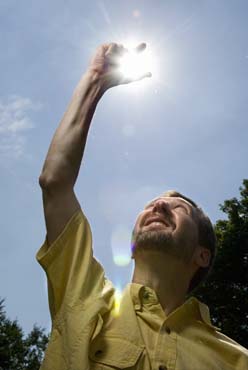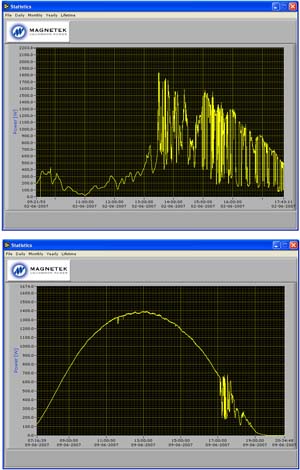UW-Madison employee shines light on solar power, energy conservation
At first glance, University of Wisconsin–Madison systems programmer Jim Winkle and U.S. Sen. Herb Kohl, D-Wis., may not appear to have much in common. But last month, both men announced their commitment to the environment by switching to solar power for most of their energy needs.

Jim Winkle, a systems programmer with the Division of Information Technology (DoIT), thinks of energy conservation while posing under the light of a sunny day outside his Madison home. Winkle recently installed a solar panel system at his house that is designed to support his household’s annual 2,000 kilowatt-hours energy need.
Photo: Jeff Miller
By the end of May, Kohl announced that the majority of his department stores in California will run using solar energy, generating 35 million kilowatt-hours of electricity in the first year.
Winkle, however, is proof that you don’t need to own a department store chain — or live on the west coast — to afford clean, renewable solar power. Thanks to tax rebates, Winkle says, the solar panel system installed at his house last week cost him $5,000 less than its $15,000 sticker price, and the rebates are continuing to grow at the state and federal level.
"These panels last so long — they have a power warranty of 25 years, and typically they last much longer, 35 or 40 years," says Winkle, who works with the Division of Information Technology (DoIT). "Once it’s paid for, we’ll have free electricity for many, many, many years."
Winkle says he expects to save up to $50,000 during 40 years using solar panels. His system is designed to support his household’s annual 2,000 kilowatt-hours energy need. This expenditure, he says, is about one-third of most households’ energy use, which he and his family have reduced through various conservation efforts, including using compact fluorescent light bulbs and gradually replacing their appliances with the most energy-efficient products available. Although the process has been a challenge, Winkle says energy conservation has never been easier than it is now.
"We’ve been working on this for probably 10 years, but now you can do it almost overnight," he says. "There are much cheaper and much better choices (for energy-efficient appliances)."
Winkle’s energy conservation at home has also led to a greater awareness of his energy use at work. He says that programs such as UW–Madison’s We Conserve, as well as programs such as Recycle Away From Home, help promote conservation in other realms of life.
"To do solar, you have to really conserve, and a lot of people conserve at home, but then when they’re at work it’s a different thing," he says. "I really admire the university’s goal to reduce energy, and it seems actually pretty doable. It seems like a pretty modest goal, but I know some people think it’s pretty challenging."

Winkle graphs the daily solar energy collected at his home. The top graph, captured on June 2, 2007, illustrates the level of solar energy collected throughout a partly cloudy day. The graph at bottom, captured on June 9, 2007, illustrates a "near-perfect solar day" and shows maximum sun exposure peaking about 1 p.m. with only a brief period of reduced solar energy late in the afternoon, likely caused by either passing clouds or late afternoon shadows temporarily cast upon the solar panels.
Image courtesy Jim Winkle
Unlike in the past, Winkle says, most solar power systems are now directly hooked up to a city’s power grid, rather than to batteries. This leads to reliable energy all year for solar users, Winkle says, and cleaner energy for utilities during the high-energy, air-conditioned summer months. The panels produce excess energy during exceptionally sunny months like May, and that energy is sold back to utilities such as Madison Gas & Electric (MG&E) at market prices, and less during darker months like November.
"Right now, outside, our meter is running backwards, which is really fun to watch. I want to videotape it and put it on YouTube," he says.
For those households that cannot afford the up-front costs of solar energy even with tax rebates, or for those who may not stay in one city long enough to save money with solar energy, Winkle says some utilities such as MG&E are providing wind power at a small premium, as low as $10 per month. Although MG&E currently has no more room on its list of wind subscribers, Winkle says the utility is building a wind farm in Iowa that will triple the wind power it can provide. Both solar and wind power, Winkle says, are cleaner than current electricity sources and are renewable.
"I’ve just become more and more aware over the years of the environmental impact of the way we live," Winkle says. "You think of [electricity] as this clean energy, this clean thing coming out of your wall outlet, but in fact it’s the largest source of greenhouse gases."
Tags: energy




